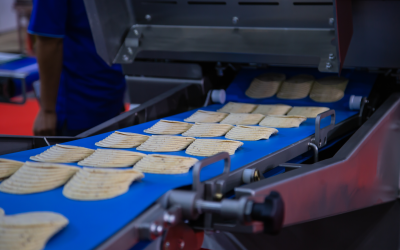Listeria is commonplace in environments throughout the food chain and has been isolated from fecal, soil, water, vegetation and various other samples collected from agricultural environments. Because Listeria is commonly isolated from agricultural environments, it is also a common contaminant of raw materials (e.g., produce, milk and meat) brought into food processing and retail facilities and may be continuously re-introduced into these environments through these raw materials. Some products (e.g., produce and raw milk cheeses) are often consumed without an additional processing step, while others are consumed following a lethality step during processing.
Although Listeria in raw materials is easily inactivated by lethality treatments (i.e., cooking and pasteurization), post-lethality exposure of finished ready-to-eat (RTE) products to the environment can lead to cross-contamination of these products by Listeria that may be harbored or persisting in the environment. Previous studies have shown that the same Listeria strains may be harbored within a processing facility for 10 years or more while undergoing minimal genetic change (Orsi et al., 2008). Since Listeria is capable of growing at under-refrigeration conditions, RTE products exposed to the environment after the lethality step are of particular concern.
Listeria monocytogenes is the only species of the 17 species within the Listeria genus that poses a significant public health threat. L. monocytogenes is a human foodborne pathogen that can cause disease ranging from mild febrile gastroenteritis to a severe invasive disease known as listeriosis. Invasive listeriosis may manifest as septicemia, meningitis, encephalitis or abortion and primarily affects immunocompromised individuals. Listeriosis has a 94% hospitalization rate, 16% mortality rate and accounts for 20% of fatalities attributed to major pathogens each year in the U.S. (Scallan et al., 2011). More than 40 species of animals and birds, including cattle, can become infected with L. monocytogenes and animals can also carry and shed the pathogen asymptomatically. A previous study showed that >20% of healthy dairy cattle shed L. monocytogenes in their feces without showing clinical listeriosis symptoms. Fecal shedding can contaminate the udder and lead to cross-contamination of milk (Nightingale et al., 2004).
The existing L. monocytogenes risk assessment identified a few specific “high risk” RTE foods (i.e., deli meats) as being responsible for the overwhelming majority of human listeriosis cases (> 90%). However, recent data demonstrated that the reduced incidence of listeriosis has not been as great as expected based on considerable reductions in the prevalence of L. monocytogenes in deli meats over the past decade. This disparity indicates that other food vehicles may be responsible for more cases of human listeriosis than estimated in the existing risk assessment.
While much of our existing knowledge regarding food responsible for the burden of listeriosis is based on large multi-state outbreaks, the majority of listeriosis cases are sporadic or occur in small clusters, where molecular subtyping and epidemiological investigations may not identify a food vehicle. Implementation of whole genome sequencing (WGS) of all human clinical L. monocytogenes isolates by the CDC and increased efforts by the FDA to sequence the genomes of isolates from food has improved detection of smaller outbreaks and identification of the food source responsible for outbreaks by increasing the resolution between matched human clinical and food isolates as compared to PFGE typing. WGS has provided insight into other food vehicles previously thought to be “low risk” and their attribution to the burden of listeriosis.
Over the past five years, multi-state outbreaks of listeriosis have been linked to a variety of dairy products, including soft raw milk cheese, raw milk, soft cheeses, ice cream, Hispanic style cheese, and ricotta salata cheese. In 2017, eight people from four states were infected with the same L. monocytogenes strain, as determined by WGS, and an epidemiological investigation identified soft raw milk cheese produced by a manufacturer in New York as the source of the outbreak. The outbreak strain was later recovered from intact wheels of the cheese from the creamery. In 2015, a large multi-state outbreak of listeriosis attributed to ice cream, elucidated the potential for foods previously not recognized to support the growth of L. monocytogenes to cause a listeriosis. Epidemiological investigations, involving combined sampling and whole genome sequencing of isolates from facilities where the food product was manufactured, demonstrated environmental cross-contamination led to a finished product containing multiple L. monocytogenes strains.
These recent outbreaks highlight the importance of cleaning and sanitation programs in all environments associated with food production, processing and handling as well as demonstrate the need for rigorous routine environmental sampling, microbiological testing and molecular subtyping to identify and control Listeria in the environment to prevent cross-contamination of RTE products. WGS has become a routine tool for microbial source tracking. The dairy industry prompted to look for additional interventions (e.g., biocontrol of Listeria using bacteriophage or probiotics for competitive exclusion) to control Listeria in the environment and growth in finished product.
References:
Nightingale, K. K., Y. H. Schukken, C. R. Nightingale, E. D. Fortes, A. J. Ho, Z. Her, Y. T. Grohn, P. L. McDonough, and M. Wiedmann. 2004. Ecology and transmission of Listeria monocytogenes infecting ruminants and in the farm environment. Appl. Environ. Microbiol. 70:4458-4467.
Orsi, R. H., M. Borowsky, P. Lauer, S. K Young, C. Nusbaum, J. E. Galagan, B. W. Birren, R. A. Ivy, Q. Sun, L.M. Graves, B. Swaminathan, and M. Wiedmann. 2008. Short-term genome evolution of Listeria monocytogenes in a non-controlled environment. BMC Genomics Nov 13; 9(1):539.
Scallan, E., P. M. Griffin, F. J. Angulo, R. V. Tauxe, and R. M. Hoekstra. 2011. Foodborne illness acquired in the United States–unspecified agents. Emerging Infectious Diseases 17:16-22.



